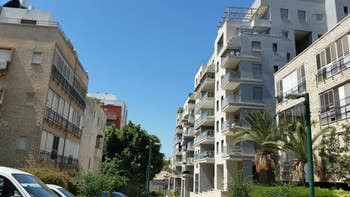The Marker, Gili Melnitsky, 28.12.2020
The local committee for planning and construction in Ramat Gan is promoting the new urban policy for urban renewal. The policy will replace the multipliers of NOP 38 and create a new urban mechanism for urban renewal projects - before the repeal of NOP 38 in October 2022.
As part of the promotion of the policy document, which is expected to be published in a few more weeks, yesterday (Sunday) the committee presented the key to the multipliers, ie the changes given in evacuation-construction projects. The new policy will include a reduction in the permutations provided in these projects.
Lowering the permits is expected to reduce the economic viability of many projects - some of which have already been promoted. In the last two years, the mayor of Ramat Gan, Carmel Shama HaCohen, has stopped the permits issued for NOP 38. According to him, the number of projects has created a burden on infrastructure and has not met urban needs.
TheMarker has learned that the new mechanism will lead to a reduction in the changes provided in most parts of Ramat Gan, including Jabotinsky, Ben Gurion, Abba Hillel and Bialik streets. The mechanism will include a multiplier of three apartments per apartment, as opposed to a multiplier of 3.5 apartments per apartment in the old mechanism.
In the heart of Ramat Gan and on Geffen and Nahalat Binyamin streets, the multiplier will be 2.8 apartments per apartment instead of three. The multiplier in Mizrahi housing, Negba Street, Borchov and Tel Yehuda will be three apartments per apartment instead of 3.5 apartments. In veteran housing, the multiplier will be 2.2 apartments per apartment instead of 2.25 apartments. The only streets where the permutations are likely to increase in a minor way are Rishonim Street and the Ramat Amidar neighborhood.

A street in Ramat Gan where some of the buildings where TAMA 38 passed Photo: Ofer Vaknin
The key to the multipliers was brought to the approval of the local committee for planning and construction in Ramat Gan, but it is part of a policy document that has not yet been published in full. As a result, no provisions beyond the new outline have yet been issued and no decision has been made as to when it will take effect.
Avraham Lahav, chairman of the Dan district in the Builders of the Land Contractors Association, criticized the outline and claimed that "the chance of urban renewal in Ramat Gan is being killed. The new multipliers are unreliable, unprofessional, and arbitrarily set. No procedure has been carried out that includes participation and consultation with the public and professional bodies regarding the outline.
"A few weeks ago, a representative of the Contractors' Association provided a professional assessment and counter-arguments regarding the economic viability of the projects. The municipal appraiser did not know how to deal with his claims. In addition, the promise to hold another professional hearing was not fulfilled.
The Builders' Association of Contractors of the Land appealed to the Ramat Gan municipality, claiming that the reduction of the multipliers is illegal. Lahav added: "Since Carmel Shama HaCohen was elected mayor, he has done everything in his power to stop plans for urban renewal. To date, he has stopped hundreds of plans that were already in the pipeline, and stalled due to frequent changes. Tel Aviv District Court stressed transparency and opinions .
"The municipality is disrespecting residents when it publishes only a key to change without a transparent discussion. It is impossible to cancel projects that have already been promoted and ignore the contractors and the public - whose plans directly affect their lives. If the current policy is promoted, we will go to court again. To do the law and do whatever it pleases. "
Advocate Micha Gidron, who specializes in planning and construction, said that "the key presented by the committee ostensibly outlines a policy for urban renewal, but it significantly reduces the chance of projects in the city. The Ramat Gan local committee repeatedly finds creative ways to reduce building rights and thus thwarts projects. "Reducing building rights makes TMA 38" TMA for the rich "because it will be economically viable to carry out projects only in the expensive areas of the city."
"The difference between the number of housing units in the previous outline and the current one is negligible in terms of the burden on the city's infrastructure, but is critical in terms of the economic viability of projects. Lowering one housing unit often decides the fate of the entire project."
No response was received from the Ramat Gan municipality .



